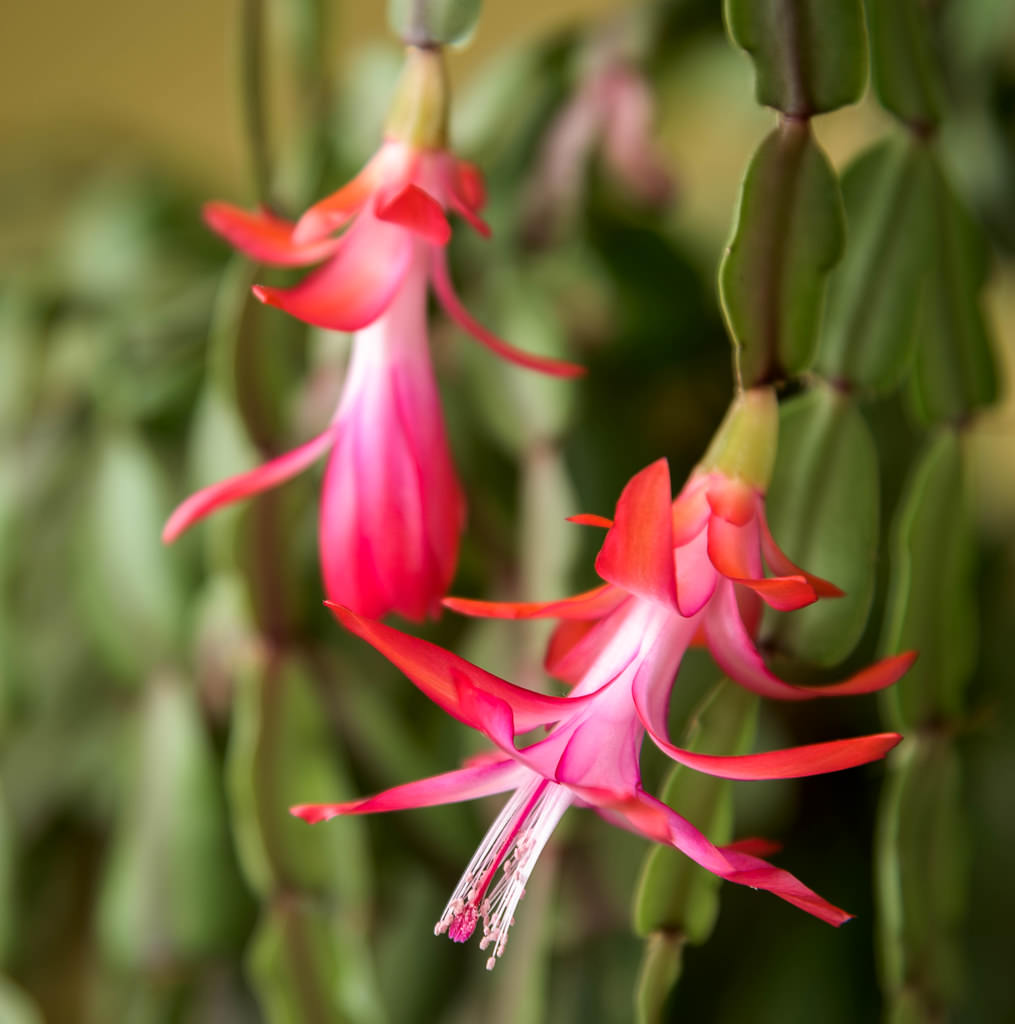3.10植物的季节变化
章节大纲
-
Lesson Objectives
::经验教训目标- Describe the seasonal changes in plants.
::描述植物的季节变化。
Lesson Vocabulary
::词汇表课程- region
::区域区域
- ecosystem
::生态系统生态系统生态系统生态系统生态系统
- biome
::生物生物
How does this plant know it's Christmas?
::这植物怎么知道是圣诞节?This plant is known as a Christmas cactus. It only blooms once a year. Can you guess when that is? Of course, the Christmas cactus blooms during the Christmas season. But how can it tell that it's Christmas time? How can a plant know the time of the year?
::这个植物被称为圣诞仙人掌。 它每年只开花一次。 你能猜到什么时候开花吗? 当然, 圣诞节仙人掌在圣诞节季节会开花。 但是它怎么看出来是圣诞节时间? 植物怎么会知道一年的时间呢?Seasonal Changes
::季节变化Have you seen the leaves of plants change colors? During what time of year does this happen? What causes it to happen? Plants can sense changes in the seasons. Leaves change color and drop each autumn in some climates ( Figure ).
::你见过植物的叶子改变颜色吗?这种变化是在哪一年发生的?是什么原因?植物能感觉到季节的变化。叶子会改变颜色,并且在某些气候中每年秋天都会下降(图 ) 。Leaves changing color is a response to the shortened length of the day in autumn.
::变换颜色的叶子是秋天白天缩短的一种反应。Certain plants only bloom during the winter. The Christmas cactus is one of these plants. Another plant that is popular during the holiday season is the poinsettia. It also blooms in the winter months. In the spring, the winter buds on the trees break open. From these buds, the leaves start to grow. How do plants detect time of year?
::某些植物只在冬天才开花。 圣诞仙人掌就是其中之一。 假日期间流行的另一种植物是薄荷植物。 它在冬季也开花。 在春天, 树上的冬芽开花。 从这些芽开始, 叶子开始生长。 植物如何测出一年的时间呢 ?You detect seasonal changes by the change in temperature. Plants do not sense temperature change. Instead, plants sense the length of daylight. Because of the tilt of the Earth, the length of daylight varies. In the winter months there are less hours of light than during summer days. That’s why, in the winter, it starts getting dark very early in the evening. It also stays dark longer. You may notice it is still dark when you get ready for school. In the summer, it will be bright early in the morning. The Sun will not set until late at night. We use a clock to determine this amount of time. With the special chemical that helps it sense light, plants can tell how long a day is.
::你通过温度的变化来检测季节性的变化。植物不感知温度的变化。相反,植物会感知日光的长度。由于地球的倾斜,日光的长度是不同的。冬天的月光亮比夏天的月光少。这就是为什么冬天的灯光开始在晚上很早的时候变暗。它也保持更暗的时间。当你准备上学的时候,你可能会注意到它仍然很暗。在夏天,它会在清晨亮亮起来。太阳在晚上才会定好时间。我们用一个钟来决定这个时间。有了特别的化学物质来帮助它感知光亮,植物就能知道一天有多长。For example, in the fall, the days start to get shorter. Trees can sense that there is less sunlight. The plant is stimulated by the shortening of the day. Chemical messages tell the leaves to change colors and fall. Not all plants use daylight as a cue.
::例如,秋天开始缩短。 树木可以感觉到阳光越来越少。 植物会因为白天的缩短而受到刺激。 化学信息让叶子改变颜色并坠落。 并非所有植物都用白天作为提示。Some flowering plants sense the length of night as a signal to flower. Each plant has a different photoperiod, or night length. When the plant senses the appropriate length of darkness, it flowers. Flowering plants are classified as long-day plants or short-day plants. Long-day plants flower when the length of daylight is long. Short-day plants flower when the day length is shorter. Long-day plants include carnations, clover, lettuce, wheat, and turnips. Short-day plants include cotton, rice, and sugar cane.
::一些花卉植物感觉到黑夜的长度是花朵的信号。每棵植物有不同的相片期或黑夜期。当植物感觉到适当的黑暗期时,它会花朵;花卉植物被归类为长日植物或短日植物;长日植物花朵,白天长;短日植物花朵,白天短。长日植物花朵包括康乃馨、花生、生菜、小麦和萝卜。短日植物包括棉花、大米和甘蔗。Lesson Summary
::经验教训摘要- Plants can respond to the change of season by losing their leaves, flowering, or breaking dormancy.
::植物可以通过失去叶子、开花或断绝宿舍来应对季节的变化。
- Plants go through seasonal changes after detecting differences in day length.
::植物在发现白天长度差异后经历了季节性变化。
Lesson Review Questions
::经验回顾问题Recall
::回顾- How do plants detect the change in seasons?
::植物如何检测季节变化?
- What signals a tree to drop its leaves?
::树的树叶会掉落什么?
- Distinguish between long-day plants and short-day plants.
::区分长日植物和短日植物。
- Give two examples of long-day plants.
::举两个长日植物的例子。
- Describe the seasonal changes in plants.

